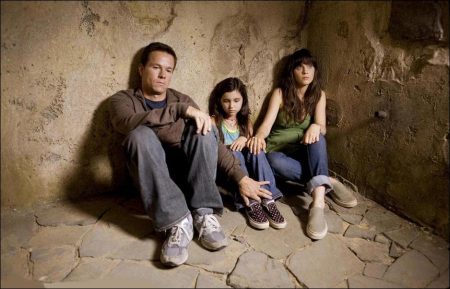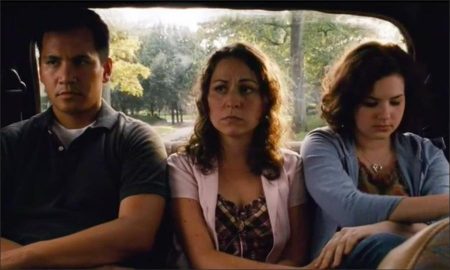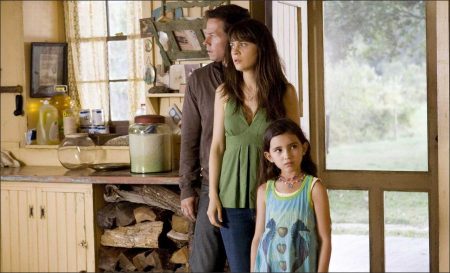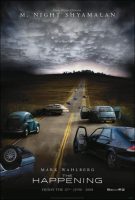Making The Happening Happen: The Design Of The Film
The Happening Movie Trailer. As with each one of his films, M. Night Shyamalan had a strong vision of how he wanted The Happening to look and feel before he ever arrived on the set. Surrounded by a group of artists, many of whom he has collaborated with before – including cinematographer Tak Fujimoto, costume designer Betsy Heimann and composer James Newton Howard – as well as some new faces, including award-winning production designer Jeannine Oppewall, he established the film’s basic creative ground rules: to turn fright and anxiety into their own strange beauty by keeping things simple.
“I wanted a very naturalistic thriller style, very clean, almost Old School, going back to before we had all these gadgets and computers, when it was all about direct, resonant storytelling,” he says. “We talked about looking at how we would make the movie if we didn’t have all these new tools and about how to really make it feel like a 2008 version of a 1950s paranoia movie.”
While The Happening is about nature going drastically awry and turning against humanity, the production would come to rely heavily on nature’s assistance. A week before filming began Shyamalan gathered his production team and told them: “This is going to be a different film journey for all of us; a road movie in a sense. Eighty-five percent of our locations are outside and the completion of the film will be up to Mother Nature’s cooperation. We are at the mercy of the elements.”
And so it was. The filmmaking team worked in sync with the weather and the landscapes, which influenced the entire design of the film. Notes multiple Oscar-nominated production designer Jeannine Oppewall, who went to school in Pennsylvania: “I think many of us had an unspoken understanding of the how the land and locations would help tell this story and how important it was going to be to create realistic sets for Elliot and Alma to move through as they journey from Philadelphia to the countryside. For me, this is the landscape of my youth and I relate to it very strongly, just as I believe Night does from having grown up here.”
Filming began August 6, 2007, notably nine years to the day since the start of production on The Sixth Sense. Shot in sequence, the 44-day production took place at a blazing speed, always on the move, switching locations every few days as the production spread out from city to small towns, following the trajectory of Elliot and Alma as they hit the road, hoping to escape. The idea was to keep the sensation of people on the run prominent in the minds of everyone working on the film.
“Every location was a new adventure,” says Jose Rodriguez. “This really was a road show and we never knew exactly what we’d be rolling up to when we came to yet another location. I think that created a great energy because everybody had to be constantly on their game. There was never time to get accustomed to a location, or slow down, which really helped to keep the actors and the crew in the middle of this intense journey every step of the way. They really felt it and I think the audience will feel it.”
Among the film’s few major interior locations was the iconic 30th Street train station in Philadelphia, a major commuter hub halfway between New York City and Washington, D.C., where Elliot, Alma, Julian and Jess start their journey to escape the city, along with hundreds of others. Amtrak granted the production rare access to the station’s halls and lobbies so long as they were able to continue running their trains, and the filmmakers were thrilled to have the chance to roam the nation’s second most active railway station and capture the marble grandeur of the station’s 1930s art deco design. “It’s just one of those building you walk into and go, ‘Wow, this is an incredibly beautiful structure,'” comments Rodriguez.
At the train station, as in the rest of the film, extras were a vital part of the terrain. In fact extras were so important to Shyamalan’s overall vision of the film, that he individually cast each and every person for the large crowd scenes. He wanted the film to be rife with the feeling that this calamity could affect anyone from any walk of life — so he needed a wide range of people, from grandmothers to business executives to farmers, to fall prey to the terrifying syndrome. “With the extras, Night wanted it to feel as if at any moment the film could follow the story of anyone in the crowd, that they were all interesting people, and that all the different colors of humanity were equally threatened,” says Mercer.
In the train scene, overwhelming tension begins to build as rumors spread through the cars like wildfire. Events climax when the train unexpectedly stops in the middle of nowhere, marooning its passengers. To shoot the scene, the production rented four train cars with the cooperation of the South Eastern Pennsylvania Railway authority.
Another primary interior was the G-Lodge restaurant in tiny Phoenixville, Pennsylvania, about 30 miles outside of Philadelphia, which stands in for the unlikely refuge of Filbert’s Restaurant, where city folk and country folk merge together in hopes of escaping the invisible killer in their midst. “We were looking for this kind of crossroads gathering spot that felt very isolated, like the place that anchors a one-horse town, and we finally found this old roadhouse from the ’20s or ’30s in Phoenixville that had all the life we wanted,” says Mercer.
Most of the film, however, takes place outside, in the wide-open vistas where nothing appears to be a threat, yet total mayhem can strike at any moment. Much of the second half of the film’s exterior scenes were shot at Walker Farm in Unionville, Pennsylvania, where 1600 lush acres provided the tall grassy fields and rolling hills for the revelatory final act of The Happening.
Here the production faced the challenge of actually controlling some of the forces of nature, in particular the wind, which becomes a major symbolic entity in the film, epitomizing the unleashed furor of earth’s natural elements. “The wind is really a character in the film and it needed to be experienced in that way,” explains Sam Mercer. We had to control the wind at various levels, so that at times it would be subtle, and others extremely violent.”
The wind was also central to what Shyamalan’s intent to distill all the monstrous cosmic forces that might turn on humanity into a simple and elemental form. The initial part of the task fell to Steve Cremin’s special effects crew, who searched for a way to depict the wind in a wide range of personas, from gentle, rocking breezes to remorseless gusts. Cremin ultimately came up with a design for large, mobile fans, some more than 20 feet in diameter that were powered by race car engines and could create far more malleable and dramatic results on camera than your typical wind machine. Later, visual effects supervisor Ed Hirsh would add digital touches to enhance the scenes even more and sound mixer Tod Maitland would collect unique recordings of wind whipping through trees, crackling through grass and howling through windows to cleverly enhance the audience’s visceral sensation of being threatened by the very air.
“The realism of the wind the FX team created really helped the actors to feel like they were caught in the middle of unusual circumstances and helped inspire the actors’ performances,” says Rodriguez.
The final and most challenging set was that of Mrs. Jones’ farm, where the eccentric senior citizen has lived for years in spartan isolation entirely off the grid. Jeannine Oppewall began with a 200 year-old farmhouse on the grounds of Ridley Creek State Park — just 16 miles outside of downtown Philadelphia but an oasis of preserved woodlands and meadows – and transformed it into a world outside of time.
Her team buried power lines, built porches, added aged shutters and erased all traces of modern life. They also planted an abundant fruit and vegetable garden that could sustain a single woman for years and brought in a bevy of rabbits and chickens. The inside of the house was lined with whimsical antiques all found in shops in the surrounding areas, ranging from a four-poster bed to the assortment of hurricane lamps that provide the home’s only source of light.
The sound of The Happening was just as important to Shyamalan as the look of the film, and he worked closely with sound mixer Tod Maitland to make sure every creak and whistle would impact the audience. “M. Night Shyamalan is the rare filmmaker who is constantly aware of sound,” says Maitland. “Even in his scripts, there is a great deal of sound detail and in this film, in particular natural sound really helps to create moments of tension and almost becomes another character.”
Shyamalan was equally focused on the film’s score for which he turned once again to his long-time collaborator James Newton Howard, whose scores — including for Shyamalan’s The Village and the recent Michael Clayton — have been nominated for several Academy Awards®.
“With James, I always go through the same process of giving him the screenplay and then talking to him about the ideas and he writes the music initially to themes and ideas rather than to the finished film,” Shyamalan says. “That process has been really organic for us, so that we’re always coming from the same creative pool.”
The writer/director continues: “For The Happening, we talked about a few different concepts for the music. One was having a kind of ‘Bolero’ feeling to it, where the music just keeps rising and rising and rising and then catches everyone like a wave over the entire movie. The other was to create a strange, dissonant feeling with percussion, sort of like in the original Planet of the Apes, the kind of sound that creates a feeling of panic and reflects all the reverse behavior that’s going on. Ultimately, James wrote a beautiful score that really drives the movie. He also created the most haunting cello theme that represents the struggle of humanity.”
After production, Shyamalan turned his focus towards working with editor Conrad Buff, who previously won the Academy Award for Titanic. Together, the two men worked to fulfill Shyamalan’s original vision: to strip the film down to its bones, keeping it fast-paced and lean. “I kept saying to him, the original Invasion of the Body Snatchers was 81 minutes, just 81 minutes!” he recalls. “That was our inspiration.”
It seemed from the moment Shyamalan first conceived of the idea for The Happening while on the road, both high speed and inspiration were always part and parcel of the story.
“This was really the easiest movie I’ve ever made overall,” says Shyamalan, “and I think it’s because it had such a strong structure and themes right from the time the story first came into my head, and that structure and those themes dictated everything from the beginning to the end. The main questions after that were always where are we on a scale of 1 to 10 in terms of terror and panic — and we just kept turning it up.”
The Happening (2008)
Directed by: M. Night Shyamalan
Starring: Mark Wahlberg, Zooey Deschanel, John Leguizamo, Spencer Breslin, Ashlyn Sanchez, Betty Buckley, Jeremy Strong, Victoria Clark, M. Night Shyamalan, Kristen Connolly, Alison Folland
Screenplay by: M. Night Shyamalan
Production Design by: Jeannine Claudia Oppewall
Cinematography by: Tak Fujimoto
Film Editing by: Conrad Buff
Costume Design by: Betsy Heimann
Art Direction by: Anthony Dunne
Music by: James Newton Howard
MPAA Rating: R for violent and disturbing images.
Studio: 20th Century Fox
Release Date: June 13, 2008
Views: 106






